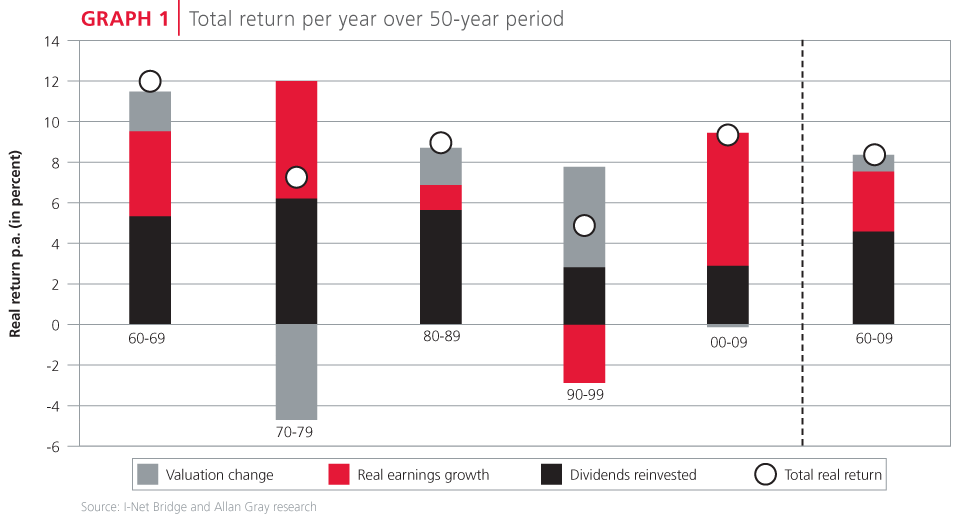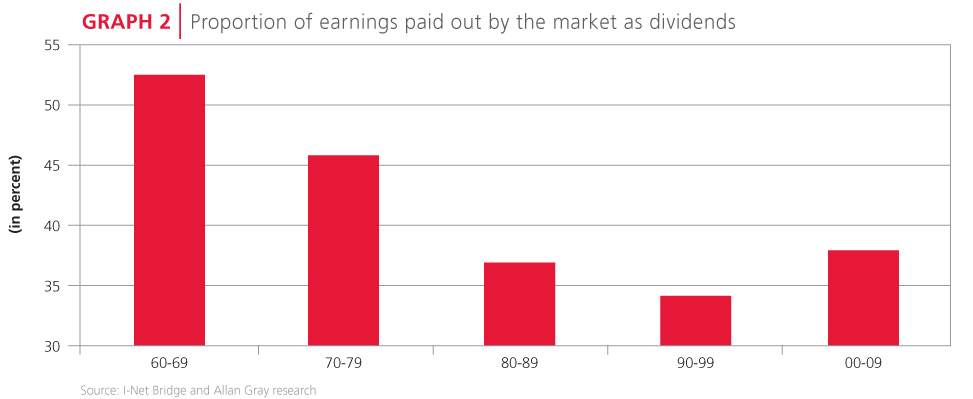In the previous edition of the Quarterly Commentary, Richard Carter and Roenica Botha demonstrated the importance of reinvesting income distributions from unit trusts for successful long-term wealth creation. Chris du Toit has revisited the history of South African stock market returns and come to the same conclusion. Over the last 50 years of equity investing, dividends have contributed more than half of the total real return earned on the JSE.
The total return from shares can be explained by the amount of dividends reinvested over time, the growth of companies' earnings and changes in the overall valuation of these earnings in the stock market.
The market returned 8.3% in real terms per year over the 50 years from 1960 to 2009
We analysed the total return of shares listed on the South African stock market, as represented by the FTSE/JSE All Share Index (ALSI) over the 50-year period from 1960 to 2009. The total return in nominal terms from the ALSI has been 17.4% per year. Inflation averaged 8.4% per year over the period, giving a real return of 8.3% per year from a passive investment in the market. Of this return, 4.6% was from reinvested dividends and 3% was from real earnings growth. The Price to Earnings (PE) ratio increased from 11.8 to 17.2 times, contributing 0.8% per year to real returns.
Changes in real earnings and valuations have been shown to be either a head- or tailwind to returns
We also analysed the contribution to total real returns over the five 10-year periods from 1960 to 2009. In each of these 10-year periods, dividends made a significant contribution to the total return. From 1970 to 1979, dividends accounted for almost the entire return. Over different periods, changes in real earnings and changes in valuations have either been a headwind or tailwind to returns. For example, between 1970 and 1979, the PE ratio of the market fell from 14.3 to 8.5, leading to lower returns from the market. During the decade from 1990 to 1999, investors benefited from expanding valuations as the PE multiple of the market grew from 10.3 to 17.8 times earnings. The effect of earnings can be just as significant, and has played a larger and much more consistent role than valuation changes over the long term. The 70s saw strong earnings growth leading to a real return of 5.8%. The 90s saw earnings fall in real terms by 3% per year.


Your starting point is important
Depending on your starting point - in other words, how high or low earnings, dividends and valuations are when you invest - each of the three factors may have a positive or negative impact on the total return from the market.
Graph 1 shows a breakdown of the total return per year over the 50-year period. It is interesting to note that dividends have become a smaller portion of returns over time. Share prices have risen faster than dividends over the 50-year period, leading to lower dividend yields. The dividend yield in 1960 was 5.2% and it is currently 2.2%. In addition, companies over time have returned a smaller proportion of their earnings to shareholders through dividends. The dividend payout ratio is the proportion of company profits that are paid out as dividends each year.
The dividend payout ratio has declined significantly since 1960
Graph 2 illustrates the average dividend payout ratio for the ALSI over the last 50 years, according to the same 10-year periods as before. The dividend payout ratio has declined from an average of 57% in the 1960s to 38% during the last decade.
COMPANIES THAT ARE CONSISTENTLY ABLE TO RETURN CASH TO SHAREHOLDERS YET STILL GROW THEIR BUSINESSES, ARE THE BEST LONG-TERM INVESTMENTS
There are many possible explanations for companies paying a declining proportion of their earnings as dividends. An alternative method of returning capital to shareholders through share buy-back programmes was allowed in South Africa from 1999. The last decade has seen the introduction of both secondary dividend and capital gains taxes, both of which impact on a company's optimal dividend policy. There are also many alternative uses of cash for companies, including growth, funding new businesses, merger and acquisition activity, capital expansion and reducing existing debt. The potential returns available from each of these alternatives at the time may also influence the decision to maintain or increase dividends.
Companies that are consistently able to return cash to shareholders yet still grow their businesses, are the best long- term investments
Shareholders enjoy returns through dividends, earnings growth and valuation changes. In the past, each of these three factors have either contributed to or detracted from the total returns of the stock market. We believe that changes in valuations and real earnings growth may not continue to provide the same tailwinds to total returns in the next 10 years. In fact a reversion to the long-term average would result in a headwind from valuations changes.
In this context, the most attractive shares for the next decade are likely to be those of companies that are able to sustainably distribute healthy dividends and yet still grow earnings in real terms. In our view, large holdings in our portfolios such as SABMiller, Remgro and BAT fall into this category.